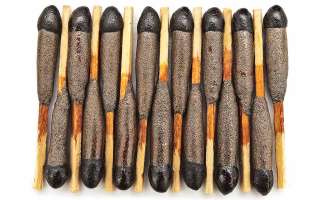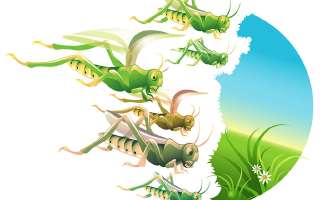Science magazine for children: Packed with science stories, science facts, science features, and other science learning resources for children. Discover the known, the unknown, and little-known facts in our science articles. Learn the how and why of everyday things and explore rare and exotic living species.
358 items in this section. Displaying page 16 of 36
How did the Safety Match Originate?
Fire was invented when two flint stones were struck together igniting a spark. From earliest times people made fire by either striking flint stones or by rubbing a hard stick against a soft one so that the friction caused soft flakes to peel off and start to smoulder. The only improvement on these primitive methods was the tinder box that contained some steel, flint, and some dry tinder for the spark to ignite. This tinder was often pieces of linen or silk....
Which is the World's Oldest Working Locomotive?
The Indian Railways is one of the world’s oldest railways dating back to 1849. It also has the largest network in terms of route length covering nearly 63,000 route kilometres touching every nook and cranny of India. The Indian Railways is also the world’s single largest employer with about 1.6 million people working in nine zones. Among its many unique gems are the toy train that runs on the Darjeeling Himalayan rail route, the rack railway at Udagamandalam in south India, the busiest narrow gauge network in the world, etc....
How do Flush Toilets Work?
Toilets are an amazing invention. Nearly every home has at least one. It is a very necessary utility needed in all homes to maintain hygiene. It is really amazing how this system works – you press a lever or pull a chain and whoosh! About two gallons of water rushes down into the porcelain bowl in three and four seconds. Gurgle-gurgle-urp it is clean and ready for use again! Toilets were known in India as early as three thousand years ago!...
Why do we See a Face on the Moon
When people say that they see a man’s face on the Moon, they are actually seeing the uneven surface on the Moon. There are deep holes, called craters, and hills on the Moon’s surface. There is no man on the Moon. That the Moon is much smaller than the stars and even the earth. In fact, four moons put together would make one earth. The Moon looks big because it is much closer to us in comparison to the stars....
What is a Tsunami?
Last year there were three more fishing villages in the Pacific island country of Papua New Guinea than there are today. You might ask why. The answer is that these three villages were washed away by an ocean wave that was more like a giant wall of water. It goes by the name tsunami, a Japanese term meaning a harbour wave. Ocean that Becomes a Giant Wall [Illustrations by Kusum Chamoli] A tsunami is caused by a disturbance in the sea floor, just like the disturbances on land....
What Toothpaste did the Ancients Use?
One of my earliest childhood memories of Delhi is seeing morning walkers, milkmen, or shopkeepers chewing away at the neem stick, much like a cow chewing the cud. It seemed strange that they should go to all that effort when readymade toothpaste was available. Neem (Azadirachta indic a) twig still used as toothbrush in many parts of India The world was divided into four kinds of people: those who used toothpaste and brush, and they were the elite; those who used tooth powder for which the index finger doubled as the brush; people who used indigenous “monkey-brand” tooth powders and lastly, those who used neem sticks which were two-in-one....
What is Vetiver Grass?
If you ask someone what vetiver is, chances are that you might get a blank look. But mention the word khus, and most people will be all-smiles. For this grass have the sweetest and coolest fragrance that beat the summer heat. That is why for centuries Indians have had vetiver or khus mats and screens in their homes. A steady sprinkle of water is enough to keep the hot summer wind out. Chrysopogon zizanioides, commonly known as vetiver found abundantly in India, is of Asian origin....
Can Fish Lay Eggs in the Mouth?
There is a kind of fish which does not use its mouth for just eating. It keeps eggs in its mouth instead of its stomach. And, it is the male fish which does it, not the female. Jawfish (Opistognathidae) are paternal mouthbrooders. Mouthbrooding, also known as oral incubation, is the care given a parent by holding its offspring in its own mouth for extended periods of time. A Nest in the Mouth [Illustration by Shridevi] After the eggs are fertilised, the male puts them in his mouth, and carries them around for a month....
Who Invented Traffic Lights?
Long before roads needed traffic lights, railways were using a system of signals to control train traffic. In the early railways, a single track was used for both up-going and down-going trains, and safety depended on spacing the arrival and departure of trains according to time intervals. These signals consisted of a ball and something that looked like a kite. When the kite was raised on top it indicated danger while if the ball was raised, it indicated the all clear....
Why do Locusts Swarm?
Have you ever tried chasing a frisky grasshopper? If you have, you will definitely know that scampering after a jumpy bug is not an easy task. Most species of grasshoppers have a keen sense of hearing and the moment they sense trouble, they can hop fast and furious! Sometimes, shortage of food turns grasshoppers into migratory insects as they venture out in search of newer pastures. This situation happens when the species begins reproducing rapidly and does not have enough food for all the members of its community....









